Mastery of urban politics helped the Irish rise from huddled masses to the heights of political power.
An Ghorta Mór, the devastating famine that drove over one-and-a-half million Irish to America, put in place the foundations of the Irish-American community for the next 120 years. The Famine immigrants were a deeply rural people. Endowed with few material resources or capital and little or no education, the great majority were utterly unprepared for instant immersion into some of the fastest-industrializing cities in the world. Yet, politically, the Irish had the advantage of having undergone a process of political initiation that was, at the time, unique in Western Europe.
The administration in Dublin, controlled from London, was often remote and, in places, fiercely resisted. But beginning in the 1820s, with his groundbreaking campaign for Catholic emancipation and in his subsequent drive for repeal of the union with Great Britain, Daniel O’Connell created one of the first mass political movements. O’Connell’s hopes for repeal were crushed by government coercion and the start of the Great Hunger. But as the massive exodus of Irish got underway, with a quarter of the country emigrating in the single decade from 1845-55, the memory of the Famine would prove indelible and the experience of political organization under O’Connell, invaluable.
The disruptions and dislocations suffered by Famine immigrants were often devastating, and the welcome they found in America was anything but warm. Instantly suspect for their religion and poverty, their presence helped spur a fierce backlash that led to the formation of the anti-immigrant American Party, the largest third-party movement in American history. Yet under the democratic reforms brought about under President Andrew Jackson, the vote had been extended to all white males and the unintended beneficiaries were the Famine Irish. Crowded into the worst slums in North America, they had the single advantage of being able to use their numbers to engineer voting pluralities and push their way ahead.
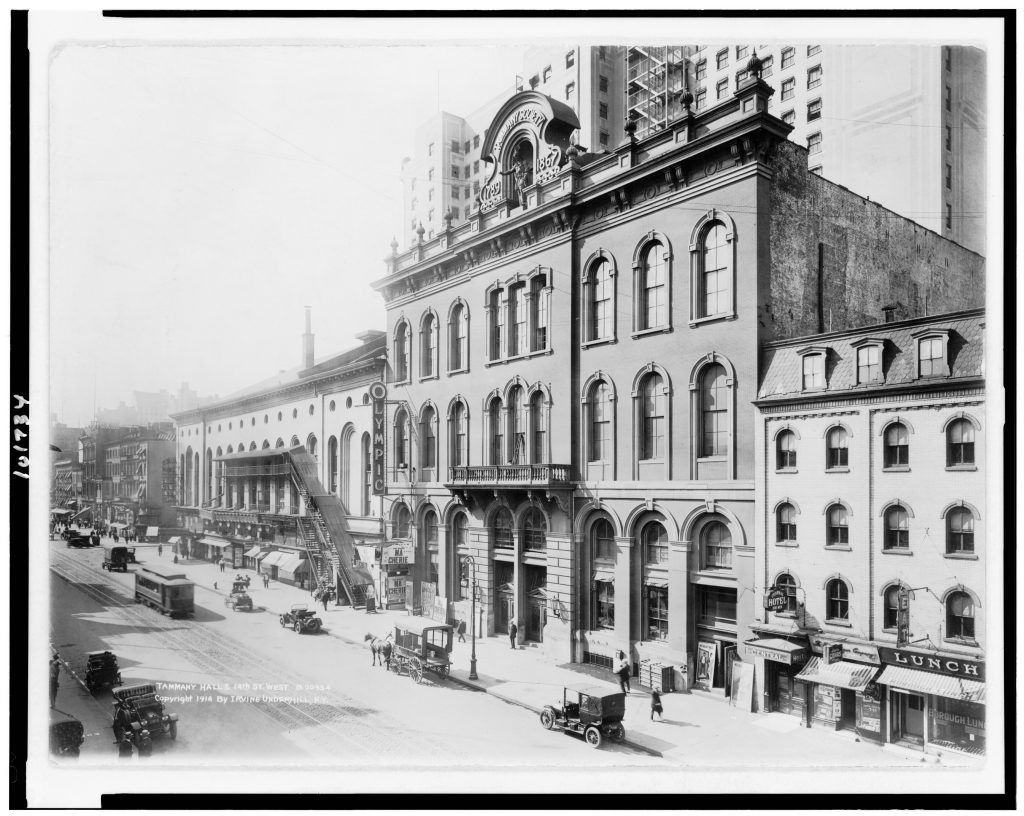
While New York’s Tammany Hall was the most famous – or infamous – Irish-American political machine, the rise of the Irish through urban mass politics is a story common to American cities from Chicago to Jersey City, from Albany to Philadelphia, from Kansas City to Boston. The big-city boss – “If I were a Republican,” said Kansas City’s Tom Prendergast, “they’d call me a leader” – not only exemplified the strengths and weaknesses of Irish machine politics, but was influential in forming coalitions that reached out to other ethnic groups, helped build the modern Democratic Party, and brought Franklin Delano Roosevelt to power and, eventually, John Fitzgerald Kennedy.
Tammany was invented by native-born American Protestants. Aaron Burr first staked out Tammany’s territory among the urban working and lower classes, and William Tweed built the Hall’s foundations as a champion of the immigrant poor. But John Kelly, the leader who picked up the pieces after Tweed’s colossal fall, set in place the organizational machine that would endure and prosper for the next half-century. “Kelly,” one observer noted, “found a mob and left an army.”
Kelly was born in 1822, the son of Irish immigrants, raised in poverty in the city’s lower wards, and made a name for himself as a boxer, actor and volunteer fireman. As well as prospering in his business as a grate-setter and ironmonger, he took an early interest in politics. Elected alderman in 1853 and Congressman in 1854 – the same year as Tweed – Kelly was the only Catholic member of the House of Representatives at a time when the nativist agitation against Irish Catholics in particular was reaching its height. (Boston wouldn’t elect its first Irish-Catholic congressman until 1880.)
Elected sheriff of New York County in 1858, a position often associated with wanton plundering, Kelly proved upright enough to earn the name (some said it was self-conferred) “Honest John.” He kept his distance from the Tweed Ring and, shattered by the death of his wife and son, was recuperating in Europe when the scandal broke. Some thought that Tammany wouldn’t survive the Tweed debacle. But Honest John accepted the position of Grand Sachem – the first Irishman in that role. He was ideal for the job. As well as untainted by the Tweed Ring, he’d come up through the streets and knew firsthand the needs and expectations of immigrant voters, particularly the Irish.
In rebuilding Tammany, Honest John laid down three enduring principles of machine politics: leadership, loyalty and money. The Boss called the shots. He collected the assessments – a percentage of future earnings – from those who were nominated to run or appointed to public office. Beneath the Boss was the widening pyramid of district leaders, precinct captains and ward heelers, so that, at its base, the machine covered not just every district and ward but every block and tenement. In many ways, the ward heelers and precinct captains were interpreters, acting as intermediaries between newly arrived, still-disoriented immigrants and the distant monolith of government. Often enough, they were the government, fulfilling all the legal and social-welfare functions that would later be assumed by public agencies.
Loyalty flowed both ways, from the Boss down through the ranks whose success at turning out the vote was rewarded with jobs for themselves and patronage for their troops. They, in turn, stuck by the leader, the ultimate source of the vital resource that kept the machine running: money.
To one degree or another, the Irish-American political machine, wherever it took root, was built on the same enduring search for security that followed the trauma of the Famine and its consequences. What William Kennedy wrote about the political machine the Irish built in Albany could just as easily apply to Honest John’s machine in New York or Hinky Dink Kenna’s organization in Chicago’s First Ward: “There was only one crime and that was going hungry. They would never let that happen again.”
Tammany and its brethren were often accused of employing a strategy of “bread and circuses” to woo and hold ignorant immigrant voters. There’s truth to that charge as long as the strategy is given its due. The bread was often badly needed, and frequently no one else was going to provide it. And the circuses were more than mere circuses. All those parades, clambakes, beefsteak dinners, Fourth of July boat rides, beer rackets – which reformers loathed and looked down on–brought light, color and enjoyment to slum dwellers whose opportunities for such things were limited at best. These entertainments were also touchstones in process of acculturation that brought immigrants of different backgrounds together to celebrate as one community.
The machine was designed to meet ad-hoc needs. It never spawned think tanks or academic affiliates. Beyond George Washington Plunkitt’s rants, it nurtured no writers or philosophers. It had little interest in national monetary policy or the country’s foreign relations. The machine was parochial, profoundly so, as grassroots as it was possible to get, infiltrating each neighborhood, linking every block and tenement to the Hall with multiple connecting lines, attentive to the here-and-now needs of the immigrant voters who shaped and sustained it. Amid the debates over the gold standard and the free coinage of silver, which animated much of the national political debates of the 1890s, Tammany boss Richard Croker remarked dismissively, “I’m in favor of all kinds of money. The more the better.”
“The abstract ideas of political honesty and efficiency played no part in the scheme of things,” one Tammany veteran wrote of the Hall. “Politics was not discussed in terms of principles platforms, or ideas. A leader was either a good man or a bad man. A good man took care of his constituents, supplied them…with jobs; he paid rents and prevented evictions. If he didn’t live up to these standards, he was a bad man…and was not destined to last very long…”
The truth behind Tammany Hall’s rich and complex history of electoral success as opposed to the black legend of Tammany as the incarnation of everything evil and reprehensible in American urban politics was perhaps never better framed than by Boss Charles Francis Murphy. “When Tammany can elect its candidate so often in a city of 6,000,000 inhabitants,” Murphy told the New York World, “in a city of intelligence, in a city dotted all over by the church spire and the school house, it seems silly to use the time-worn campaign cry that there is nothing good but everything corrupt in Tammany.”
Murphy’s parents came to New York from Ireland in 1848, at the height of the An Ghorta Mhóir. Born in 1858, the second of nine children, he grew up in the Gas House District on the of Manhattan’s East Side, a densely packed working-class neighborhood. Murphy was steeped in the life of immigrant New York and the post-Famine culture of urban Irish America. He was five when the Draft Riots tore the city apart and by age 13, the year of the Orange Riots, he was working in a wire factory.
In 1875, he landed a job driving a Manhattan horsecar, and was saved from spending perhaps a lifetime in that position by the name he made for himself as an amateur baseball player. A popular local figure, he raised enough money to open his first saloon in 1880. The path from saloonkeeper to politics was already well trod, and Murphy’s reputation for athletic prowess, likeability and keeping his word all helped make him local district leader. Murphy didn’t buck Croker’s leadership of the Hall, but he ran his fiefdom his own way, without the thuggery and often blatant corruption in which Croker’s lieutenants indulged.
When Croker finally departed, he, like Tweed, left the Hall in disarray. After a brief experiment with a triumvirate, leadership passed to Murphy. The contrast with Croker was dramatic. A man of so few words he was popularly known as “the silent boss,” Murphy once told Jimmy Walker that “most of the troubles of the world could be avoided, if men opened their minds instead of their mouths.” He avoided the conspicuous sporting life of Dick Croker and, according to his biographer, there was never any question about “the moral blamelessness of his personal affairs.”
Except for a brief stint as a commissioner of docks, Murphy never held any public office, but no Tammany sachem before or after ever wielded as much power. He elected three governors (and had one of them, William Sulzer, impeached), three mayors, two senators, and innumerable judges, aldermen, assemblymen and congressmen. He successfully battled the greatest press baron of his day, William Randolph Hearst, and took Tammany to the threshold of the White House.
Where Croker was distant and dictatorial, Murphy was involved and supportive. According to one contemporary, Murphy “played umpire, not dictator,” and though he relied on Tammany’s everyday ranks of undistinguished ward heelers and party stalwarts, he went out of his way to promote men of talent to the top. Among them were U.S. Senator Robert Wagner and New York Governor Al Smith, two of the most capable and progressive political leaders in American history. In Al Smith, Murphy believed he might even be able to do the unimaginable and put an Irish Catholic in the White House.
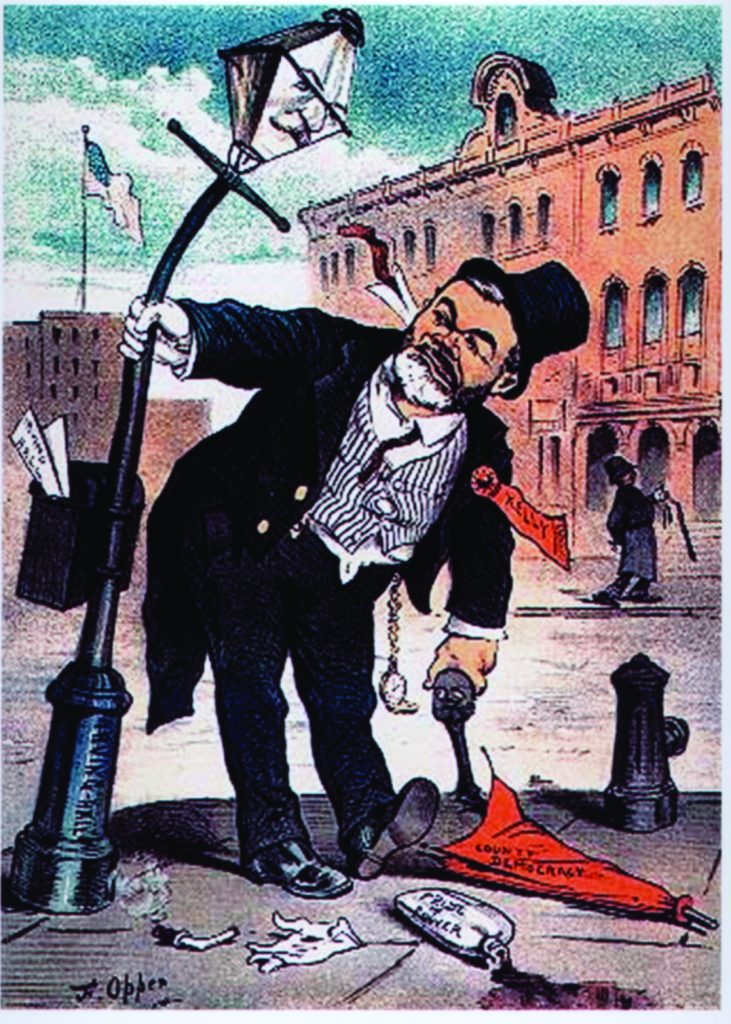
Murphy didn’t start out as a reformer in the traditional sense. Reform stood for efficiency and economy in government, for the provision of public services through government agencies that acted with administrative neutrality, and the staffing of public jobs through a rigorous, non-political process of Civil Service testing. While he put an end to Tammany’s alliance with gamblers and brothel owners, reigned in the wanton, flagrant corruption that Croker both blessed and participated in, and promoted honest men like Wagner and Smith, Murphy wasn’t about to obliterate the Hall’s powers of patronage, which was the very basis of the machine.
The bond between Tammany and its constituents depended on profligacy and generosity, not efficiency and economy. The people have the right to expect, as James Michael Curley of Boston put it, “something nobler and higher than thrift in the man they elect.” When in need, the poor didn’t want to suffer the interrogation of by-the-book professionals. They wanted to turn to people like themselves who didn’t require a list of assets or reams of paperwork before they offered assistance. The contractors who regularly feasted on work steered their way by Tammany knew that, given their ethnic backgrounds and upstart operations, they’d probably be out of the running in an open competition against long-established, tightly managed firms run by well-trained professionals. Tammany’s supporters wanted a leg up, not a laissez-faire market.
Murphy appreciated and rewarded the loyalty of Tammany braves as part of the enduring underpinnings of the Hall’s power. But he also recognized that as America transformed itself into a hugely dynamic and impersonal industrial behemoth, the old-style politics couldn’t suffice. Neither hand-outs, nor baskets of coal, nor patronage jobs, nor even ad-hoc interventions by local leaders could protect the masses against the concentrated power of corporations and industrial combines or meet the long-term needs of millions of aged, disabled, underprivileged and unemployed. Yet if Tammany didn’t do something to help address these problems, Murphy came to realize, other organizations would and the Hall would shrivel into irrelevancy.
The standard bearer of Murphy’s new form of machine politics was Al Smith. Like Murphy, Smith was a poor kid of Irish ancestry. (The Irish ethnicity of Smith’s mother, Catherine Mulvehill, herself the daughter of Famine immigrants, was the one he always identified with, though his father was a mix of Italian-German). He grew up on the Lower East Side. Born in 1873, Al Smith got no further in school than an eighth-grade education, but he too proved his worth on the streets, as an amateur actor and a worker at the Fulton Fish Market. He had the talents of a natural politician, and before long his local leader, Big Tom Foley, nominated him for state assembly.
Unsure at first, feeling out of place among legislators far better educated and experienced than he, Smith gradually rose to the challenge and became a master of the assembly’s rules and procedures. By 1911, eight years after being elected, he was the speaker. With Murphy’s backing, Smith began to advance an increasingly progressive agenda that included the country’s first compulsory workmen’s compensation law.
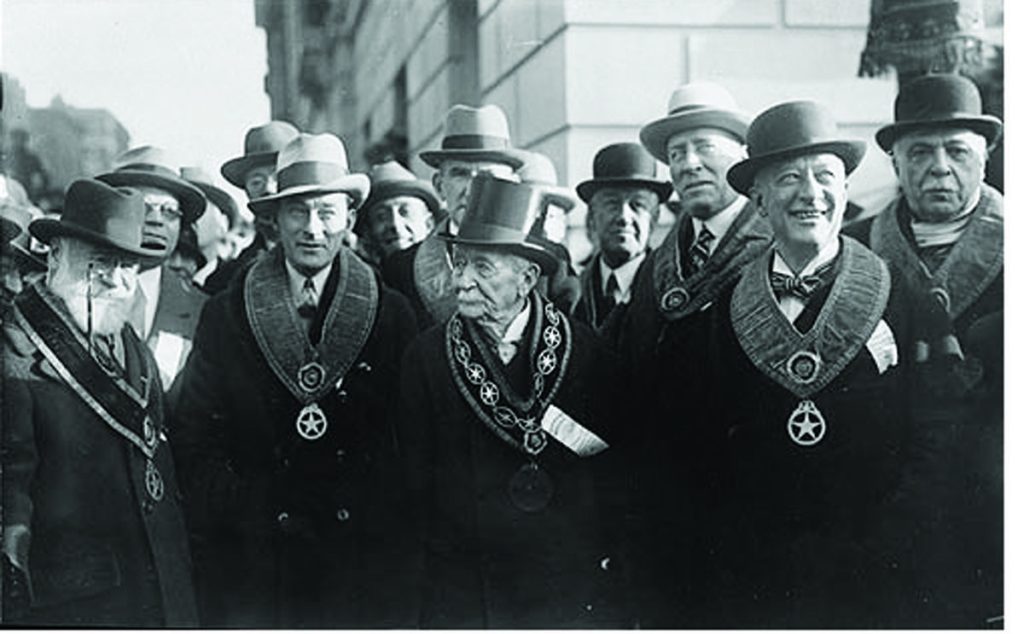
If there’s a moment from which to date the evolution of Tammany from a local political machine – which reflected the defensive crouch of Famine immigrants determined to deliver themselves from attempts by their soi-disant moral betters to control and shape their behavior – into an aggressive national force for progressive social change, it was March 25, 1911. On that day, 146 garment workers, mostly young Jewish and Italian women, perished in a fire at the Triangle Shirtwaist Company, in lower Manhattan. As a state legislator, writes Smith biographer Robert Slayton, “Smith had learned about the nuts and bolts of the political system, [but] what he lacked was a cause, a rationale for using that expertise. The Triangle Fire would provide that and more, as it would fundamentally alter how he viewed the very role of government in American life.”
Three months after the fire, the legislature set up a nine-man Factory Investigating Commission to examine working conditions across the entire state. The chairman and vice-chairman were Senate Majority Leader Robert Wagner and Assembly Speaker Al Smith. (Cynics dubbed them “The Tammany Twins”). The commission was exacting in its investigations and eventually produced over 25 bills. The resulting legislation revolutionized the workplace and created protections and safety measures that extended the role of government in unprecedented ways.
It didn’t stop there. The legislature moved ahead on everything from the passage of once-unthinkable stock market regulations to widow’s pensions and public power, from the state primaries to the direct election of U.S. senators. “By blessing the Factory Investigating Commission and endorsing the vote for women,” concludes David Von Drehle in Triangle: The Fire That Changed America, “Murphy helped chart the future of American liberalism…In the generation after the Triangle fire, urban Democrats became America’s working-class, progressive party.”
Under Murphy and Smith, Tammany became an agent of progressive change, and given New York’s position in the American economy, the influence of legislation passed in Albany had national impact. Murphy raised no objections when Smith brought Jewish progressives like Belle Moskowitz and Robert Moses into his inner circle; he was, said Ed Flynn, “as vitally interested in Smith’s social reforms as anyone around the Governor.” But his motivation was always practical rather than ideological. He believed that using the power of the state to improve people’s lives in material ways – guaranteeing decent working conditions, shielding workers from injuries, regulating the employment of women and children, protecting the old from falling into poverty, extending public education – was, quite simply, good politics.
In 1918, Al Smith was elected governor of New York State. He lost his bid for re-election in 1920, but was returned to office in 1922 and served until 1928. During those years, he continued to build on his progressive record in the assembly. He overhauled and modernized the entire structure of state government, bringing it into the twentieth century; passed massive bond issues for hospitals, housing, roads; undertook a dramatic expansion of state parks and invested new funds in education. A model for the kind of dynamic government action that Franklin Roosevelt would undertake as president, Smith’s achievements have often been referred to as “the Little New Deal.”
Al Smith’s outstanding legislative record and achievements as governor brought him national attention. Murphy was soon convinced that putting a loyal Tammany man, a Catholic no less, in the White House–a notion that a few years before would have been unthinkable–was now eminently achievable. Smith shared his ambition. He believed very deeply that the urban immigrant community he represented and took pride in was ready to assume its rightful place in the country’s democratic equation.
However premature or naïve such confidence may have been, Murphy didn’t live to see the result. He died suddenly in 1924, shortly before the Democrats met in New York for their convention. Smith went ahead with his bid for the nomination. After a bitter deadlock that lasted a record 103 ballots, the convention settled on a compromise candidate. More ominous was the failure of the convention to adapt a plank strongly condemning a reborn and widely influential Ku Klux Klan.
Four years later, in 1928, Smith secured the nomination. Given the high-octane prosperity of the “Roaring Twenties,” which was then at its height, any Democratic candidate would have an uphill battle. But Smith wasn’t any candidate, and the heights he faced weren’t so much steep as un-scalable. The Party itself was deeply fractured. While many urban ethnics like Smith saw Prohibition as a nativist power play by rural Protestant America, as grossly unfair was it was unrealistic and unenforceable, a large part of the agrarian populist wing was devoted to it.
The weight of economic good times gave the Republicans an advantage that under the best of circumstances would have been difficult to overcome. But in combination with a widespread, vocal, often hateful revival of old-time suspicions about Catholic loyalties, Smith’s indelible identity as an Irish pol and his classic “New Yawk” accent – available for the first time to millions of voters via radio – didn’t endear him to rural Americans and helped generate a Republican landslide of historic proportions.
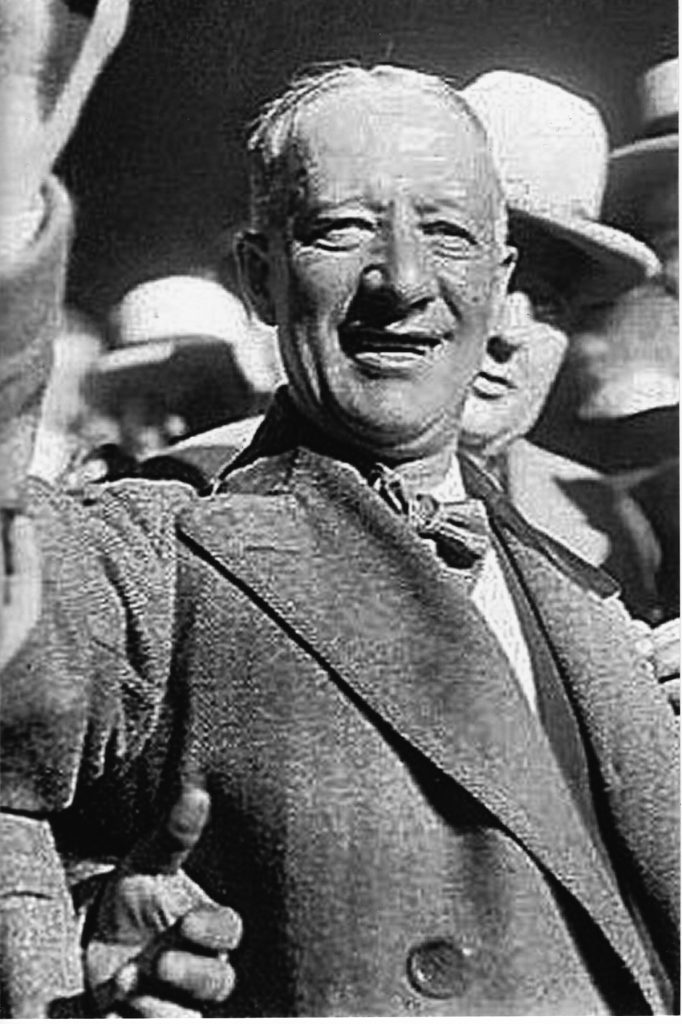
In the aftermath, Murphy’s machine seemed to come apart. Smith grew bitter and resentful toward his successor as governor, Franklin Roosevelt, and drifted away from the Democratic Party. Another of Murphy’s protégés was the brilliant, witty, debonair Jimmy Walker, perhaps the most naturally talented politician Tammany ever produced. His combination of New York street smarts, intellectual wattage, Irish charm and jazz-age sophistication made “Beau James” one the most popular mayors in the city’s history. Unfortunately for Walker, however, he was elected mayor the year after Murphy died.
“The brains of Tammany now lie in Calvary Cemetery,” lamented Walker after Murphy’s death. Worse, Tammany’s conscience lay there, too. Walker’s charm couldn’t cover the fact that the corruption Murphy had worked so hard to contain if not eradicate was once again out of control, and as the cold realities of the Depression set in, the public rapidly lost its tolerance for Jimmy’s fast and easy ways. The revelations made by the Seabury investigation and a public hearing in front of Governor Roosevelt in Albany led to Walker’s resignation as mayor in 1932.
Tammany’s subsequent history is a shadow of what came before, but Murphy’s legacy didn’t end with the eclipse of Tammany. Murphy had anointed another important protégé in Ed Flynn, the leader of the Bronx Democratic organization, who was proud of the fact that “whatever knowledge of politics I have I learned through Mr. Murphy.” Much as Murphy had recreated Tammany after Croker, Flynn represented the next iteration in the machine’s evolution from engine of post-Famine reorganization to key player in the coalition that would empower F.D.R. and the New Deal, and elect J.F.K. president.
There was only one crime that was going hungry. They could never let that happen again.”
The nomination in 1960 of John Kennedy as the Democratic presidential candidate was the culmination of the process of reorganization that defined the post-Famine experience of Irish America. The descendant of Famine immigrants and Irish-American pols (his maternal grandfather, John Fitzgerald – aka “Honey Fitz” – was the mayor of Boston), Kennedy was not only handsome, articulate and a war hero, he was also a product of exclusive prep schools and Harvard University. On the surface he bore little resemblance to politicians like Al Smith.
For all his upper-class finesse and Ivy League polish, however, there was never any doubt that John Kennedy was an Irish Catholic. As Tom Maier makes clear in enlightening book, The Kennedys: America’s Emerald Kings, J.F.K. had a thorough grasp of Irish history and a deep appreciation of his own family’s place in the journey out of Famine Ireland into America.
Professor Lawrence McCaffrey, the dean of Irish-American history, has identified the common denominator among Irish-American pols this way: “The famous Irish political style was shaped by Irish history, Catholic communal values, and confrontations with British imperialism and colonialism. In their efforts to free themselves…the Irish learned to compete within the context of the Anglo-Protestant political system.” Beginning with Daniel O’Connell and continuing in America, writes McCaffrey, “they became particularly adroit in the techniques of mass agitation, political organization and confrontation, and liberal-democratic politics.” The makings of Kennedy’s historic victory rose out of this Irish insistence on retaining their identity while refusing to accept second-class citizenship.
At the heart of the matter would always be the catastrophe of the Famine. It was the great divide–an economic and existential upheaval that transformed the landscape of Ireland and the mindscape of the Irish, both at home and in the diaspora that it helped bring about. A physical wound and physic humiliation, it dwarfed the effects of any battlefield rout. Whether spoken about or not, the Famine was always there, embedded in Irish America’s very foundations, in ambitions, fears, doubts, in the expectations Irish Americans passed to their children, in how they worshipped and worked, in their religious, educational and social organizations and, above all, in their politics. The experience of political initiation under O’Connell took on new meaning and significance in the trans-Atlantic passage to America.
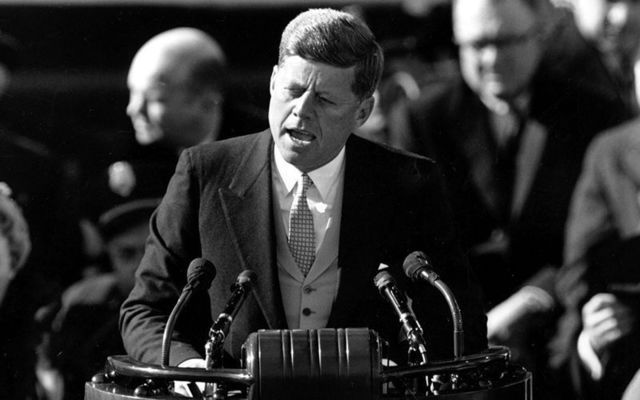
Nobody has spoken more movingly of that passage and what it meant than J.F.K. In testament to history’s love of improbable outcomes, this great-grandson of Famine emigrants, who a century and a quarter before left a wrecked, enfeebled province of a globe-girding empire for an uncertain future in a country that held their condition pitiable and their religion contemptible, became the first sitting President of the United States to visit Ireland and address the parliament of what was now an independent nation.
In his speech to the Dail in 1963, Kennedy said, “…no country contributed more to building my own than your sons and daughters. They came to our shores in a mixture of hope and agony, and I would not underrate the difficulties of their course once they arrived in the United States. They left behind hearts, fields, and a nation yearning to be free. It is no wonder that James Joyce described the Atlantic as a bowl of bitter tears. And an earlier poet wrote, ‘They are going, going, going, and we cannot bid them stay.’”
In the long perspective of history, the Irish recovery was swift. But it was a trying, difficult century for those who labored against poverty and prejudice in America, and against the underlying “cosmic insecurity” that the Famine instilled. On their journey to the White House, Irish-Americans had to build and pave a road that no minority group had ever before traveled.
Progress was often uncertain; the slights and suspicions hurled against them, hurtful. There were no precedents to follow. They had to muster the resources of political will and organizational skill to break down barriers of class and religion, to manage the trick of staying Irish while becoming American and to forge coalitions capable of asserting the rights of working-class immigrants against economic and social elites.
The political machines built – or, in many cases, adapted – by Irish leaders like Murphy in New York or O’Connell in Albany or the Pendergasts in Kansas City (all of them the descendants of Famine immigrants) were anti-millennial. Politics, Tom Pendergast was fond of saying, is concerned with “things as they are.” The machines cared nothing about ultimate goals or societal transformations. Their concerns were immediate and ruthlessly quotidian. Their tactics were practical (if not always legal) and their thinking was never ideological. They had none of the Marxist philosophy that shaped many German and Jewish immigrants, and dreams of revolution never reached the drawing board.
In their origins, the machines were defensive organizations, part of an immigrant community’s attempt to regroup and reorganize itself in the wake of a catastrophe that caused the greatest concentration of civilian suffering and death in Western Europe between the Thirty Years’ War and World War II. They were an answer to the powerlessness and humiliation experienced by people whose daily existence had long depended on institutions and rulers over whom they had exerted no control.
The machines shouldn’t be romanticized. There’s no doubt they were riddled with corruption (and the corruption often grew worse at moments when the entire country was off on one of its financial benders or a strange interlude like Prohibition made illegality easy and lucrative). There’s also no doubt that, as well as serving up some extraordinary political figures like Charles Murphy and Al Smith, the machines added a degree of practicality and democratic realism to American politics. In the long run they served their primary purpose, giving the Irish and other immigrants space to reorganize apart from the control of Anglo-Saxon ruling classes and assisting their passage into America. The machines eventually went away not because they were corrupt or intrinsically evil but because they’d served their purpose and weren’t needed anymore.
The magic moment came with J.F.K.’s inauguration as president. Irish Americans, once despised as immiscible outsiders whose presence threatened the very future of the American republic, were now quintessential insiders. “After Jack Kennedy, anything was possible,” writes William Kennedy. “Goddammit, we’ve been president, and you can’t hold us back anymore.”
In a wider sense, the long-standing notion that America’s highest elective office was forever reserved for one group of Americans to the exclusion of all others had been dispelled. In traveling the road they did, Irish Americans had opened that road for others to travel.
Editor’s Note: This issue was originally published in the June / July 2010 issue of Irish America.

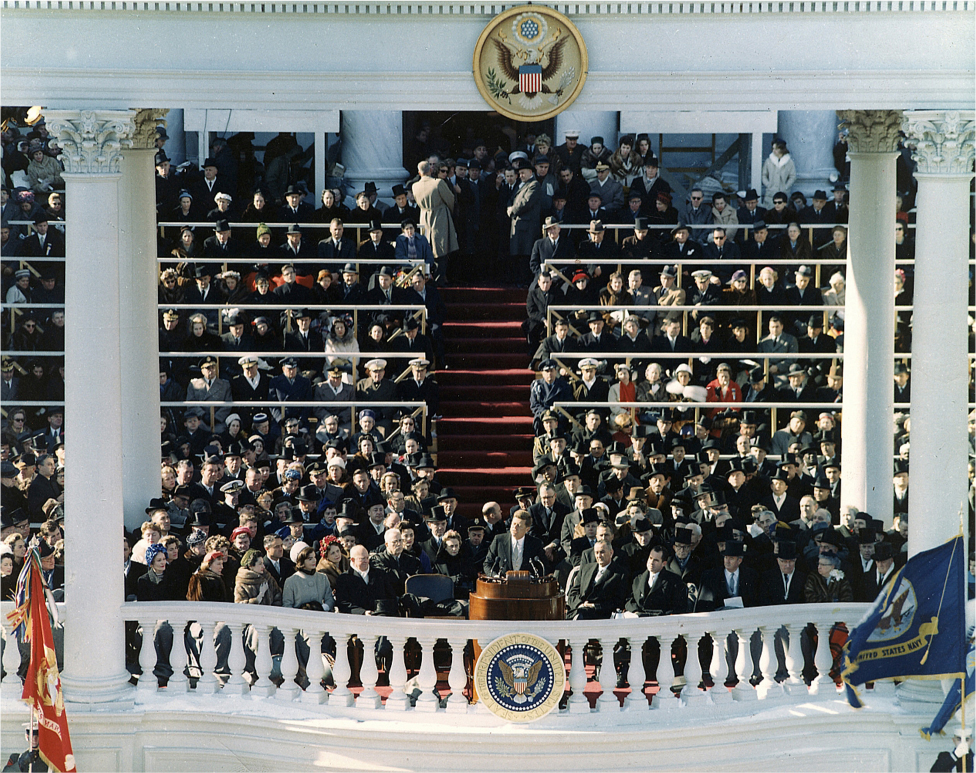
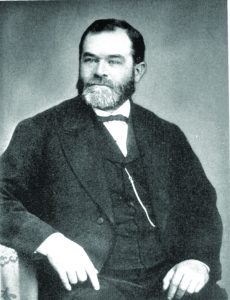
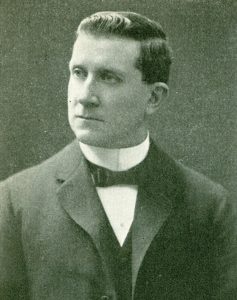
Leave a Reply